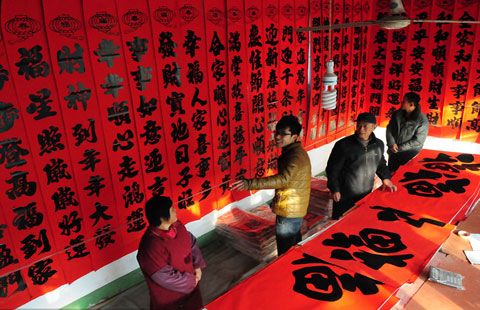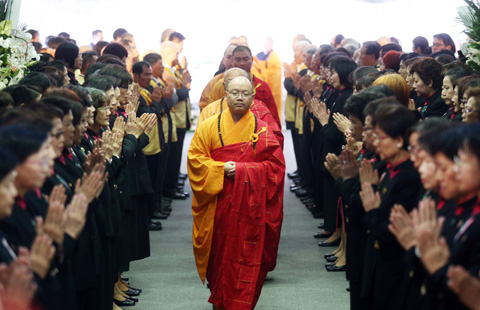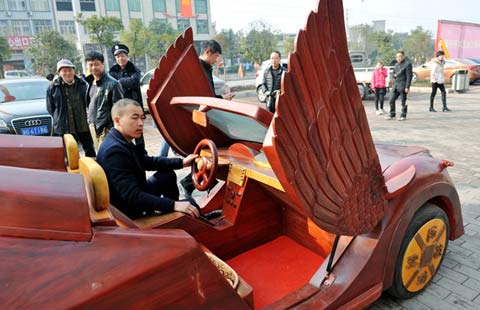Vessel of culture
Updated: 2015-02-11 07:45
By Yang Feiyue(China Daily)
|
||||||||
Jingdezhen has for centuries remained a receptacle of Chinese porcelain culture. The city lures artists from home and abroad, who flock to China's china capital to create. Yang Feiyue reports.
Perhaps nothing better represents China than china. And perhaps no place represents China's china better than Jiangxi province's Jingdezhen, hailed as the country's "porcelain capital" since ancient times.
Travelers visit the city's ancient kilns in a park that displays the historical legacy surrounding the settlement's porcelain production.
I was stunned to see an elderly man effortlessly carry about six-dozen bowls on a specially made wooden shelf.
Then I watched Wang Yansheng spin a lump of yellow clay into a bowl at the park's production-demonstration site. The man in his late 70s started making porcelain at age 11 and has devoted his life to the trade.
"What matters most is perseverance and the pursuit of perfection," Wang says.
He explains he's still learning and innovating.
The demonstration site is nestled in a nearly 200-meter-long alley.
It shows each step, including shaping, trimming and painting.
Wang Shenfang, who has painted unfired pieces for three decades, decorates ceramic works with tea flowers and sickles with quick flicks of her brush. Her brush seems to dance as she finishes a bowl in about half a minute.
The park houses kilns from the Qing (1644-1911), Ming (1368-1644), Yuan (1271-1368) and Song (960-1279) dynasties. The gray-brick furnaces are fired up for demos on Cultural Heritage Day on the second Saturday of June and the Jingdezhen International Ceramic Fair every Oct 18-20.
The park also hosts porcelain musical-instrument performances.
Jingdezhen's historical legacy draws contemporary artists from around the world. They congregate in Dongshi district, where they operate studios and galleries in a modern porcelain plant.
Many foreigners come during the April-July and September-October periods, a plant worker says.
Seoul native Jung Gilyoung has lived in Jingdezhen for three years.
"I could only make small pieces in South Korea because of technical restrictions," the 55-year-old says.
"But the skilled craftspeople here make large pieces possible."
Jung's works incorporate sculpting and painting.
Australian Naoko Yehenara creates modern pieces depicting her homeland's flowers, birds and blue skies, and flower arrangements in porcelain vases.
She's constructing an exhibition room.
"Jingdezhen is a sacred place for porcelain," she says.
"The atmosphere makes me much more creative."
She stays in the city for half of every year.
"Back in Australia, I had to do everything, from casting earthenware to firing," she says.
"It was exhausting. I could only make a few pieces a month."
She used to ask her students to help. But they can't compare to Jingdezhen's skilled craftspeople.
Yehenara hires locals to reproduce molds she makes on larger scales.
"I can find the best materials here, which can endure high temperatures," she says.
"That's crucial to bringing out the distinctive colors."
The presence of foreign artists has given the city an international flair.
Yehenara says she often runs into old friends from elsewhere in Jingdezhen, including one she hadn't seen in five years.
Many foreigners visit the weekend porcelain fairs.
Visitors can easily see how porcelain continues to sculpt Jingdezhen's legacy.
Contact the writer at yangfeiyue@chinadaily.com.cn
(China Daily 02/11/2015 page24)

 Consul general weighs in
Consul general weighs in
 10 destinations favored by Chinese property investors
10 destinations favored by Chinese property investors
 Spring Festival goods in the making
Spring Festival goods in the making
 New Year scenes preserved in old photos
New Year scenes preserved in old photos
 Remembering the dead on the seventh day after TransAsia crash
Remembering the dead on the seventh day after TransAsia crash
 A homeward bound motor "gang"
A homeward bound motor "gang"
 Farmer builds sports car out of wood
Farmer builds sports car out of wood
 Bleak outlook for art students six months after graduation
Bleak outlook for art students six months after graduation
Most Viewed
Editor's Picks

|

|

|

|

|

|
Today's Top News
President Xi to visit US in September
Study sees consumer confidence faltering
NBC News anchor Brian Williams suspended
US confirms death of IS-held hostage
High royalties key reason behind Qualcomm fine: NDRC
Net regulator to meet US ambassador on WeChat
The peeping eyes of the United States
January inflation cools to 0.8%
US Weekly

|

|







